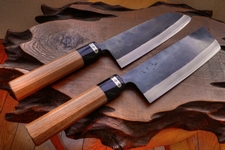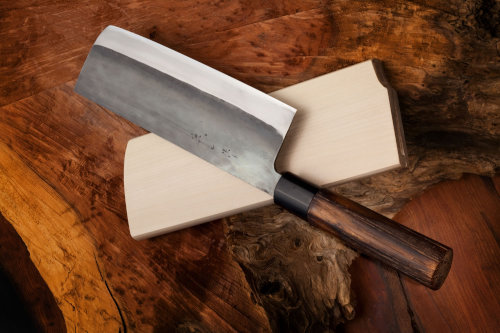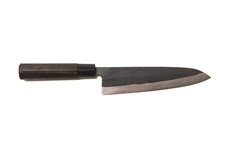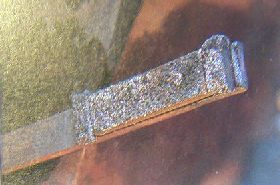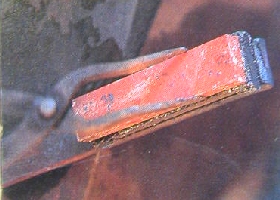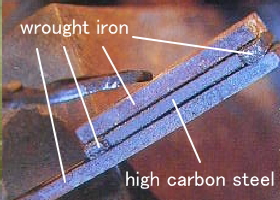YANAGI KNIVES
- Yanagi 210mm white JPY44,000
- Yanagi 300mm white JPY76,000
- Yanagi 300mm white with saya JPY90,000
- Yanagi 330mm white JPY91,000
- Yanagi 360mm white JPY142,000
- Yanagi 210mm blue JPY54,000
- Yanagi 240mm blue JPY62,000
- Yanagi 270mm blue JPY76,000
- Yanagi 300mm blue JPY91,000
- Yanagi 330mm blue JPY142,000
- Yanagi 360mm blue JPY170,000
- Takohiki 330mm blue JPY142,000
- Takohiki 360mm blue JPY170,000
- Fuguhiki 240mm blue JPY62,000
 PIC
PIC - Fuguhiki 270mm blue JPY76,000
- Fuguhiki 300mm blue JPY91,000
- Fuguhiki 300mm blue Honyaki JPY191,100
DEBA KNIVES
- Deba 150mm blue JPY40,000
- Deba 165mm blue JPY43,000
- Deba 180mm blue JPY48,000
- Deba 210mm blue JPY72,000
- Deba 240mm blue JPY93,000
- Mioroshi Deba 180mm blue JPY42,000
 PIC
PIC - Mioroshi Deba 210mm blue JPY57,000
GYUTO KNIVES  custom handles
custom handles  PIC1,
PIC1,  PIC2,
PIC2,  PIC3,
PIC3,  PIC4
PIC4
- Kurouchi Gyuto 210mm stainless clad blue JPY50,000
 PIC1
PIC1 Gyuto 210mm stainless clad blue JPY51,000 PIC1 ,
PIC1 ,  PIC2 ,
PIC2 ,  PIC3 ,
PIC3 ,  PIC4 ,
PIC4 ,  PIC5
PIC5 - Gyuto 210mm stainless clad blue, thin customize JPY63,000
- Iron clad Gyuto 210mm with dragon and tiger engraving JPY160,000
 PIC
PIC - Gyuto 210mm stainless clad, honduras rose octagon JPY73,000
 PIC
PIC - Kurouchi Gyuto 240mm stainless clad blue JPY62,000
 PIC
PIC - Kurouchi Gyuto 240mm stainless clad blue, chestnut JPY72,000
 PIC
PIC Gyuto 240mm stainless clad blue JPY63,000Gyuto 240mm stainless clad, honduras rose octagon JPY83,000 PIC
PIC- Kurouchi Gyuto 270mm stainless clad blue JPY69,000
- Gyuto 270mm stainless clad blue JPY70,000
- Kurouchi Gyuto 180mm with custom handle
 LINK
LINK
- Sujihiki 240mm stainless clad blue JPY63,000
 PIC
PIC - Sujihiki 270mm stainless clad blue JPY70,000
USUBA KNIVES
- Usuba 180mm blue JPY52,000
- Kintaroame Usuba 180mm blue JPY114,400
- Usuba 210mm blue JPY60,000
- Usuba 240mm blue JPY79,000
- Kamagata Usuba 180mm blue JPY52,000
- Kamagata Usuba 210mm blue JPY60,000
- Kamagata Usuba 240mm blue JPY79,000
- Lefted Kamagata Usuba 210mm blue JPY84,000
- Mukimono 180mm blue JPY55,000
- Lefted Mukimono 120mm blue JPY51,800
BONING KNIVES
- Garasuki 180mm blue JPY61,000
- Garasuki 210mm blue JPY84,000
- Garasuki 240mm blue JPY108,000
SPECIAL PURPOSE KNIVES
- Sabaki 180mm blue JPY48,000
![]() Click the video "a user in Russia"
Click the video "a user in Russia"
- Unagisaki 180mm white JPY46,000
 PIC
PIC
Please ![]() e-mail us for any further information!
e-mail us for any further information!


